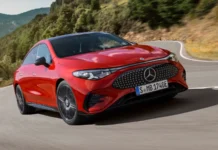
The 2016 Nissan Maxima, which has been on sale now for about a month, is touted by the company as a “four door sports car,” but how does it stack up against the original?
Although the 1989 Nissan Maxima is technically the third generation of the model, it’s the first one that Nissan marketed as a four door sports car, complete with the “4DSC” logo on the window. It was also the first generation of Maximas not available as a station wagon, further emphasizing its role as the sports sedan of the Nissan lineup.
The 2016 Maxima is all new, with an aggressive exterior design highlighted by a prominent chrome grill and a “floating roof” design similar to the Murano SUV, where the roof and rear panels are bisected by a black strip, giving the illusion of the roof floating above the body.

The old Maxima isn’t nearly as radical in design, having a conservative late-80s design that is handsome but not daring. The family resemblance to other Nissan models is especially evident in the front end, which looks very similar to a Sentra of the same period.
Both generations of Maximas have the same basic configuration – a mid-size, three-box sedan with a naturally-aspirated V-6 engine driving the front wheels. From there, though, the latest Maxima trumps the old with 300 horsepower from its 3.5-liter V-6, compared to 160 horsepower from the 89’s 3-0 liter V-6. Later model years of this generation saw a power boost to 192 horsepower for SE models.

Notable on the old Maxima, but conspicuously absent from the new one, is the availability of a manual transmission, in this case a 5-speed. The new Maxima is only available with an Xtronic CVT. The old one could also be had with an old-tech 4-speed automatic.
Despite the 300-plus-pound weight advantage of the old model, the new Maxima’s prodigious power gives it a much better power-to-weight ratio, which should add up to faster acceleration. The new Maxima also beats the old one at the pump, with a city/highway rating of 22/30 compared to 18/24 for the old Maxima.
Outside, the new Maxima is considerably larger than the old one, being nearly five inches longer, almost six inches wider and sporting a wheelbase that’s four inches longer. Despite the larger dimensions, legroom front and rear are very close, the newer model having a two-inch advantage in the front and only a one-inch advantage in the back.
When adjusted for inflation, both generations are in the same price bracket. The base model 1989 Maxima comes in nearly $2,000 higher in 2015 dollars, but the high-end Platinum version of the 2016 Maxima is nearly $4,000 dearer than the high-end SE version of the 1989 Maxima, albeit with more luxury features and options.
The new Maxima is arguably the better vehicle, with modern amenities, modern safety ratings, more power, better fuel economy and greater luxury appointments. The old one, however, has lighter weight and an available 5-speed manual on its side. On that basis alone, the old Maxima, while not being the better car, might just be the better four-door sports car.
Which one do you think is the better four-door sports car? Leave your comments below.
Check out the table below for the side-by-side comparison of the 1989 Maxima versus the 2016 Maxima:
| 1989 Nissan Maxima | 2016 Nissan Maxima | |
|---|---|---|
| Price range: | $17,447 to $18,824 ($34,087 to $36,100 in 2015) |
$32,410 to $39,860 |
| Engine: | V-6 | V-6 |
| Displacement: | 2,960 cc | 3,498 cc |
| Horsepower: | 160@5,200 rpm | 300@6,400 rpm |
| Torque (lb-ft): | 181@3,200 rpm | 261@4,400 rpm |
| Fuel economy (city/hwy): | 18/24 mpg | 22/30 mpg |
| Transmission: | 5-speed manual, 4-speed auto | CVT |
| Wheelbase: | 104.3 in | 109.3 in |
| Length: | 188.2 in | 192.8 in |
| Width: | 69.3 in | 73.2 in |
| Height: | 55.1 in | 56.5 in |
| Weight: | 3,150-3,200 lbs | 3,471-3,593 lbs |
| Legroom front: | 43 in | 45 in |
| Legroom rear: | 33 in | 34.2 in |
And check out this TFL Car video first drive review of the 2016 Nissan Maxima:






















